Types of Reproduction
Living beings mainly reproduce by two methods – asexual reproduction and sexual reproduction. The modes by which different organisms reproduce depends on the body design of the organisms.
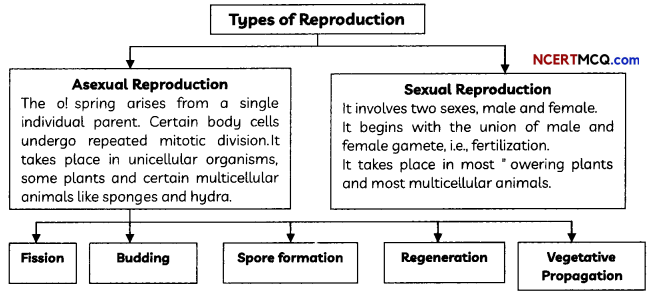
Asexual Reproduction
Characteristics
- Certain body cells of an organism undergo re-peated mitotic divisions and form two or more new individuals of the same kind.
- The new individuals produced are genetically identical to their parents.
Advantages
- Asexual reproduction is simple and fast.
- Takes place in those organisms having simple body structures.
Disadvantages
- Evolutionary change is not possible as no variation is produced. A species consequently cannot adapt to changes in its environment.
- Asexual reproduction produces identical organisms generation after generation. In case of any defect in the parent organism, the offspring also inherits it.
![]()
Methods of Asexual Reproduction
Asexual reproduction occurs in various ways which are described below:
Fission
It is the simplest method of asexual reproduction in unicellular organisms, such as amoeba, paramecium and other protozoa.
Different patterns of fission have been observed:
(A) In some organisms such as Amoeba, the splitting of the two cells during division takes place in any plane.

(B) In Leishmania, the binary fission occurs in a definite orientation in relation to the whip-like structure called flagellum present at one end of the cell.
(C) In Plasmodium, the cell divides into many daughter cells simultaneously by multiple fission. Sometimes, during unfavorable conditions, a cyst or protective wall is formed around the cell and inside the cyst, the nucleus splits several times to form many daughter nuclei. This increases chances of their survival in favourable conditions.
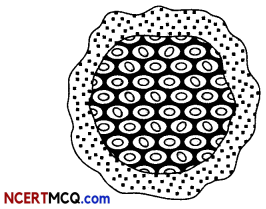
Multiple fission in plasmodium
Example 1.
How does binary fission differ from multiple fission?
Answer:
Binary fission: Some unicellular organisms under favorable conditions simply split into two equal halves during cell division. This is called binary fission. Examples are different bacteria and protozoa such as Amoeba.
Multiple Fission : Some organisms like the ma-larial parasite, Plasmodium, divide into many daughter cells simultaneously. This division process is called multiple fission.
Fragmentation
Fragmentation is the process of breaking off a piece of organism followed by mitotic cell division. Meiosis is not involved in this process as it is a mode of asexual reproduction. The broken part can develop into an independent adult.
Fragmentation process is limited to invertebrates, and it is absent in vertebrates. The ability of fragmentation depends on the complexity of the organism.
Budding
It takes place in multicellular organisms like hydra and yeast. A bulging or bud appears on the body as a result of repeated mitotic division.
Budding in Yeast: During budding in yeast, a small daughter bud is formed on parent and continues to grow until it gets separated. The daughter cell is generally smaller in size as compared to parent.
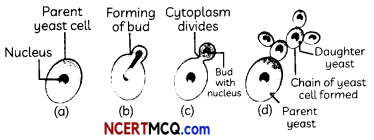
Budding in Hydra: In hydra, the cell divides rapidly at a specific site and develops as an outgrowth called bud. These buds while attached to the parent part develop into small individual. When the small individual becomes Large enough, it detaches itself from the parent body to exist as an independent individual.
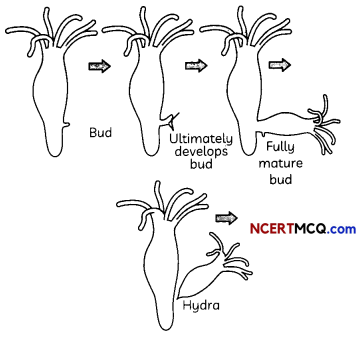
![]()
Differences between Budding and Fission
| Budding | Fission |
| 1. The parent individual persists after the daughter cells daughter individual has budded off. | 1. The parent individual loses its identity after splitting into two or more |
| 2. Bud starts as a trace and slowly grows to an appropriate size before it pinches off but it is still smaller than the parent | 2. The daughter individuals are identical in structure but all are smaller in size than the parent. Later they grow to attain their normal dimensions |
| 3. Budding is rather slow and gradual | 3. Fission is rapid and instantaneous |
Spore Formation
Spore formation is the most common method of asexual reprod uction in majority of fungi and bacteria like rhizopus, mucor, penicillium.
During spore formation, a structure called sporangium develops from the fungal hypha.
The nucleus divides several times within the spo-rangium, and each nucleus, with a bit of cytoplasm, develops into a spore.
The spores are liberated and they develop into new hypha after reaching the ground or substratum.
The spores are covered by thick walls that protect them until they come into contact with another moist surface and can begin to grow.
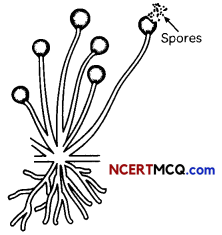
Example 2.
How will an organism be benefited if it reproduces through spores?
Answer:
The spores are covered by thick walls of tiny blob-on-a-stick Like structures, which are not reproductive parts, but protect the spores from unfavorable conditions, until they come into contact with moist surface and begin to grow. Such spores are produced in Large numbers and can spread through air, water or animals in contact. They germinate when conditions are favorable. Thus, organism like rhizopus is benefited greatly when it is produced through spores.
Regeneration
Regeneration is a modified form of fragmentation. It is known as a process that makes genomes, cells organs, organisms, and ecosystems resilient after disturbances or damage. Regeneration is carried out by specialized cells. From this mass of cells, different cells undergo changes in an organised sequence referred to as development to become various cell types and tissues.
Planarian flatworms are highly adapted with regeneration capabilities because of their asexual reproduction method. Star fishes also have the same ability to regenerate their arm, but unlike tailed amphibians and lizards, lost arms of star fishes could regenerate a complete new organism.
![]()
Example 3.
Can you think of reasons why more complex organisms cannot give rise to new individuals through regeneration?
Answer:
More complex organisms cannot give rise to new individuals through regeneration because complex organism are multi-cellular organisms. In complex organisms, specialised cells are or-ganised as tissues, and tissues are organised into organs, which are strategically placed to perform different specialized functions. The tis-sues in complex organisms cannot regenerate a new individual as cell-by-cell division would be impractical.
Difference between Fission and Fragmentation:
In fission, a unicellular organism breaks up to form two or more daughter organisms, whereas in fragmentation, a multicellular organism breaks up to form two or more daughter organisms.
Difference between Fragmentation and Re-generation
| Fragmentation | Regeneration |
| 1. Occurs in multi-cellular organisms with relatively simple body organization. | 1. Occurs ¡n several fully differentiated organisms. |
| 2. Organisms simply break up into smaller pieces upon maturation. These pieces or fragments grow into new individuals. | 2. If the individual is accidentally cut or broken up into man pieces, many of these pieces grow into separate individuals. |
| 3. Fragmentation results in the production of identical offprings. | 3. In regeneration, the entire organism can regenerate as in certain animals ke Planaria, but mostly the organism regenerates only a part of the body. |
| 4. No specialized cells ore involved in fragmentation. | 4. Regeneration is carried out by specialised cells. These cells proliferate and make a Large number of cells. From this moss of cells, different cells undergo changes to become various cell types and tissues. |
| 5. Example: Spirogyra | 5. Example: Crabs can regenerate legs. Mammals can regenerate liver cetts and blood cells. Lizards con regenerate their toil |
Vegetative Propagation
Vegetative propagation is a method of reproduction in some higher plants in which a new plant develops from the vegetative parts of a plant such as root (as in dahlia, sweet potato), stem (as in ginger, potato, onion) or leaf (as in bryophyllum).
Advantages of vegetative propagation
- Plants raised by this method can bear flowers and fruits earlier than those produced from seeds.
- It is a cheaper, easier and more rapid method of propagation in plants as compared to growing plants from their seeds.
- The traits or characters of the parent plant are preserved. That is, all plants produced are genet-ically similar enough to the parent plant to have all its characteristics.
- Better quality of the plants can be maintained.
- Those plants which do not produce viable seeds or seeds with a prolonged period of dormancy, such as banana, orange, rose, jasmine, etc., can be propagated by this method.
![]()
Example 4.
Case Based:
Take a potato and observe its surface. Cut the potato into small pieces such that some pieces contain a notch or bud and some do not. Spread some cotton on a tray and wet it. Place the potato pieces on this cotton. Note where the pieces with the buds are placed. Observe changes taking place in these potato pieces over the next few days. Make sure that the cotton is kept moistened.
Select a money plant. Cut some pieces such that they contain at least one leaf. Cut out some other portions between two leaves. Dip one end of all the pieces in water and observe over the next few days.
(A) Select the incorrect observation regarding the first activity.
Notches can be seen on the surface of the potato.
All potato pieces showed growth of young shoot and roots.
The potato pieces which were having buds in notches did not show growth of young shoot and roots.
The pieces which were not having eye buds did not show any growth of shoot or root.
Both (I) and (II)
Both (II) and (III)
(I), (II) and (III)
(II), (III) and (IV)
Answer:
(b) Both (II) and (III)
Explanation: All potato pieces did not show growth of young shoot and roots. Growth of shoot and roots was shown by those potato pieces only which were having buds.
(B) In the second activity, the portions of money plant which grow and give rise to fresh leaves are:
(a) Those which have buds
(b) Those which have spores
(c) Those which have flowers
(d) Those which have nodes
Answer:
(d) Those which have nodes
Explanation: The portion of money-plant having left at the node show formation of fresh leaves. There are buds in the axil (point of attachment of the leaf at the node) of leaves that develop into shoots. These buds are called vegetative buds. A bud consists of a short stem around which immature overlapping leaves are folded. The vegetative buds can also give rise to new plants.
(C) What conclusions can be drawn from the second activity?
Answer:
It can be concluded from the second activity that green leaves can synthesize food and have the ability to grow into a plant through vegetative propagation.
(D) Which parts of a plant develop into new plants by vegetative propagation?
Answer:
Plant parts like roots, stem and leaves develop into new plants under appropriate conditions by vegetative propagation.
Explanation: All new Bryophyllum plants are genetically similar to their parent plant as they are produced when the buds produced in the notches along the leaf margin of Bryophyllum fall on the soil and these develop into new plants.
(E) Assertion (A): All new Bryophyllum plants are genetically similar to their parent plant.
Reason (R): New Bryophyllum plants develop from the stems of their parent plant.
(a) Both (A) and (R) are true and (R) is the correct explanation of the assertion.
(b) Both (A) and (R) are true, but (R) is not the correct explanation of the assertion.
(c) (A) is true, but (R) is false.
(d) (A) is false, but (R) is true.
Answer:
(c) (A) is true but (R) is false.
Explanation: All new Bryophyllum plants are genetically similar to their parent plant as they are produced when the buds produced in the notches along the leaf margin of Bryophyllum fall on the soil and these develop into new plants.
![]()
Tissue Culture
New plants are grown by removing tissue or separating cells from the growing tip of a plant. The cells are then placed in an artificial medium where they divide rapidly to form a single group of cells or callus. The callus is transferred to another medium containing hormones for growth and differentiation. The plantlets are then placed in the soil so that they can grow into mature plants. It is commonly used for ornamental plants.
Advantages of tissue culture:
- It is a very fast technique. Thousands of plantlets can be produced in a few week’s time from a small amount of plant tissue.
- Many plants can be grown from one parent in disease-free conditions.
- It can grow plants round the year, irrespective of weather or season.